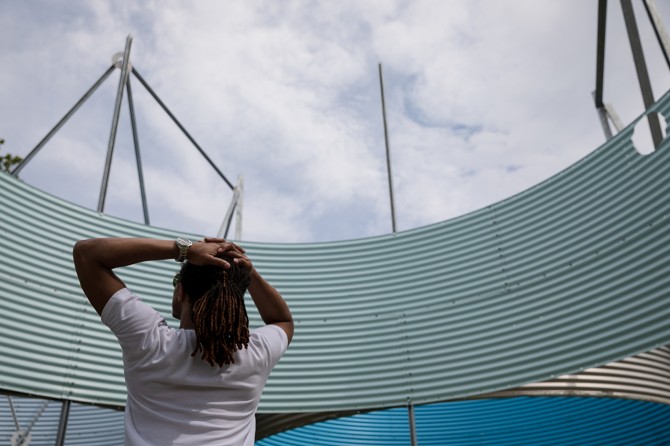
Visitors walk past the “Oculi” pavilion during the FigmentNYC festival on Governors Island.
'Oculi' pavilion opens to public at NYC arts festival
By Daniel Aloi
“Oculi” has landed in New York City’s postindustrial landscape – not from outer space, but rural Ohio by way of upstate New York.
The pavilion made from reused metal grain bins is a collaborative project of four Cornell faculty members and a team including students and alumni. It won the 2018 City of Dreams design competition and opened to the public June 23 at Figment, a participatory arts festival on Governors Island. The pavilion is in place until Oct. 31 near the Brooklyn Ferry terminal.
The collaborators on “Oculi” are Austin+Mergold, the design practice of assistant professor of architecture Aleksandr Mergold, B.Arch. ’00, and Jason Austin, B.Arch. ’00; associate professor of art Maria Park; and consulting engineers Chris Earls, professor of civil and environmental engineering, and Scott Hughes of Silman Structural Engineers, a visiting lecturer in the College of Architecture, Art and Planning’s (AAP) New York City program.
Austin+Mergold describes the grain bins, commonly seen across rural America, as “artifacts of the American agro-industrial age” on the pavilion’s project signage.
“They also look pretty cool, in general,” Mergold said. “People have been asking if this is an art installation or a scientific experiment – I usually say it’s both.”
“Oculi” is a term used in architecture for circular openings or features resembling eyes. The pavilion’s “eyes” are on the skies over the island – painted inside surfaces of each of the elevated grain bins match different colors of the daytime sky, a palette created by Park. Shadows cast by the bins also track the movement of the sun.
“It has a kind of strangely optimistic sci-fi feel,” Park said.
The bins came from a farm in Delphos, Ohio, and were shipped to a site in King Ferry, New York, for fabrication and painting before going to New York City for installation on Governors Island in May. The 172-acre island in lower New York Harbor is a former military base the city took over in 2003.
“The installation looks at home on the side of the island facing the old industrial Brooklyn waterfront, with the background of [former] U.S. Coast Guard barracks in disuse and disrepair,” Mergold said. “The bins are probably the same age as those buildings.”
“It’s kind of a post-apocalyptic looking site,” Figment executive producer David Koren said.
In this setting, “‘Oculi’ problematizes the issue of what to do with the stuff we already have but seem to no longer need: buildings, things, materials, technology,” Mergold added.
Art and architecture students in AAP assisted in the preparation of materials and the “Oculi” project installation.
“In King Ferry, the students were involved in preparing and painting the panels of the grain bins, which, by the way, weigh a lot,” Park said. “Another team of AAP students helped with the installation on the island.
“Given the nature of the work involved, one could definitely say it was a team – if not a trust-building exercise,” she said. “After the intense experience of getting the structure in place, when I see the work, I see the people who put it together.”
The student assistants are Curtis Ho and Jin Woo (Eric) Lee, both B.F.A. ’20; Libby Rosa, M.F.A. ’19; Kate Huffman, M.F.A. ’18; Anna Warfield, B.F.A. ’18; Ami Kurosaki, B.Arch. ’21; Jason Lin, M.Arch. ’20; Emma Boudreau, Sarah Bujnowski, Isabel Branas Jarque, Xiaoxue Ma and Hafsa Muhammad, all M.Arch. ’19; Vaharan Elavia and Jiacheng Xu, both M.Arch.II ’18; Sasson Rafailov, B.Arch. ’18; and Chris Morse, M.Arch. ’17.
After the pavilion is uninstalled this fall, Austin+Mergold intend to repurpose the bins further, upcycling them in an experimental housing cluster in central New York – revisiting a yet-unrealized project that in concept preceded “Oculi.”
Koren sees Figment as a catalyst in the island’s transformation to a public park with an arts, education and culture agenda. The nonprofit organization’s free arts festival draws from 15,000 to 25,000-plus visitors to the island over its two days. More than 75 artists, performers and creative projects were selected to participate this year, and art exhibits continue all summer.
“When we started in 2007, a writer from The New York Times came out before the weekend and his article called it ‘Burning Man East, surrounded by water,’” Koren said. Figment has since grown to host participatory arts events in 19 cities and five countries.
FigmentNYC features a new “City of Dreams” pavilion each summer. Held since 2010, the “City of Dreams” competition garners 100 to 200 submissions a year and promotes sustainability in architecture and design.
“They’ve all been really different,” Koren said of the winning entries. “We’ve had pavilions made out of water bottles, aluminum, milk crates; all of them highlighting sustainability by taking materials out of the waste stream.”
The competition is hosted by Figment, the Emerging New York Architects Committee of the American Institute of Architects’ New York Chapter and the Structural Engineers Association of New York.
Media Contact
Get Cornell news delivered right to your inbox.
Subscribe


